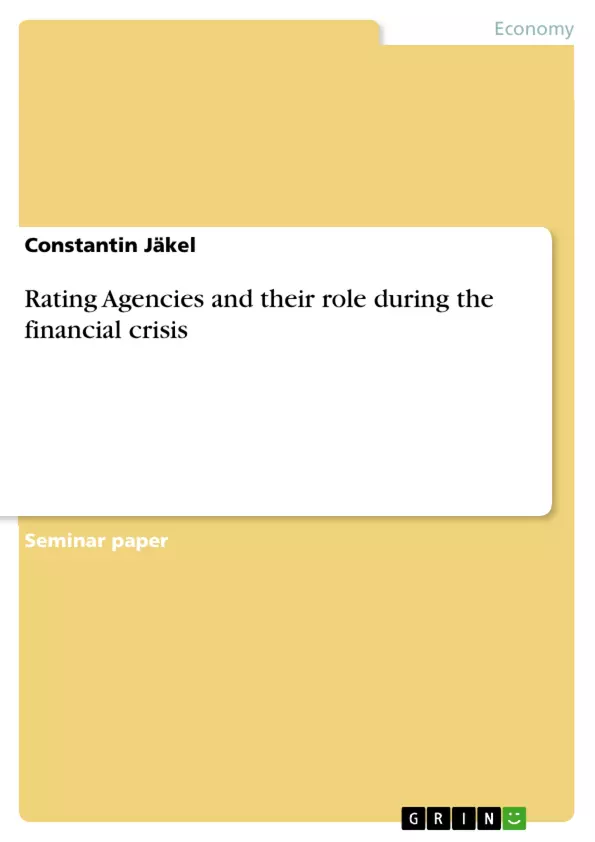After the Asian crisis during the 1990s and the startling insolvencies of Enron and Parmalat, the recent financial crisis is one the most important trigger to raise doubt concerning the proper work of rating agencies. They are criticized because of their various conflicts of interest and obvious deficits in practicing their rating methods. The rating agencies should be jointly responsible for the emergence of the so-called bubble markets during the last couple of years. Because of these bubbles and their boom and burst effect, private as well as institutional investors lost enormous sums of assets and single countries were thrown into financial turmoil. Because of these facts, the discontent concerning the rating agencies grew. People took additional notice of their market power, which they only obtained because of their influence on the global capital flows and the use of ratings to regulate the financial markets. To particularize the issues, it is helpful to bring up the year 2007, when the delayed payments among the subprime loans became more frequent. This was due to the slower increase of the housing prices and the rising short-termed interest. Consequently, the rating agencies depreciated a lot of these structured financial products, many of which had received the highest seal of quality before (AAA). Those actions both led to a massive loss of confidence on the investors’ side and a remarkable decline of liquidity. The former market of securitization products no longer existed. Influenced by this development and because they were considerable involved in this securitization business, a lot of banks also got into this downstream.
In the first part of this term paper I will present some general facts about the rating agencies including their history of origins. Afterwards I will mention the process of rating and the problems, which led to the misconduct during the crisis. This will also include a discussion concerning the IOSCO Code of Conduct and the deduced implications concerning the malfunction of the rating agencies. Last but not least I will give a conclusion and suggest some essential aspects which should be implemented from the rating agencies.
Inhaltsverzeichnis (Table of Contents)
- Introduction
- Rating Agencies
- Types of Rating
- The "Big Three"
- The Rating Process
- Procedure of Rating and its Shortcomings
- Usage of the Gauss-Copula-Model
- The IOSCO Code of Conduct
- Transparency of the Rating Methodology
- Human Resources
- Monitoring
- Conflict of Interests
- Conclusion
- Sources
Zielsetzung und Themenschwerpunkte (Objectives and Key Themes)
This term paper aims to critically assess the role of rating agencies during the financial crisis, exploring their potential shortcomings and the impact of their actions on financial markets and investors. The paper will focus on the historical context of rating agencies, their rating process and its shortcomings, as well as the significance of the IOSCO Code of Conduct in addressing potential misconduct.
- The role of rating agencies in the financial crisis
- The history and development of rating agencies
- The rating process and its potential shortcomings
- Conflicts of interest and the impact on rating objectivity
- The IOSCO Code of Conduct and its implications for the rating industry
Zusammenfassung der Kapitel (Chapter Summaries)
- Introduction: This chapter sets the stage by highlighting the significance of rating agencies in the global financial system and their role during the recent financial crisis. It explores the criticism they faced due to conflicts of interest and flaws in their rating methods, emphasizing the impact of these issues on investors and global markets.
- Rating Agencies: This chapter provides an overview of rating agencies, their purpose, and the types of ratings they provide. It introduces the "Big Three" agencies - Standard & Poors, Moody's, and Fitch - outlining their historical development and evolution. It also discusses the importance of rating agencies in the securitization of mortgage credits, highlighting how their evaluations influenced investor decisions.
- The Rating Process: This chapter delves into the actual rating process, exploring the procedures involved and the potential weaknesses in the methodology. It discusses the use of the Gauss-Copula-Model in the rating process, outlining its limitations and potential for error. It also examines the IOSCO Code of Conduct, which aims to address concerns about transparency, conflicts of interest, and other ethical issues within the rating industry.
Schlüsselwörter (Keywords)
This paper focuses on the critical evaluation of rating agencies, specifically their role during the financial crisis. Key terms and concepts explored include: credit ratings, rating process, conflicts of interest, IOSCO Code of Conduct, financial crisis, securitization, structured financial products, subprime loans, and investor confidence.
- Quote paper
- Constantin Jäkel (Author), 2011, Rating Agencies and their role during the financial crisis, Munich, GRIN Verlag, https://www.grin.com/document/175078



